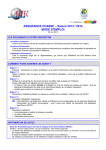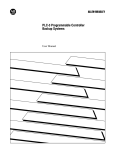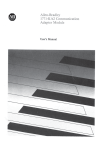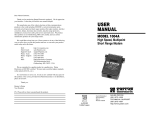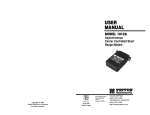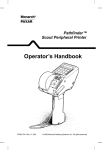Download Allen Bradley 1771DB Manual
Transcript
SATEC POWERMETERS SATEC COMMUNICATION DRIVER FOR ALLEN-BRADLEY 1771-DB BASIC MODULE Installation and Operation Manual SATEC Ltd. The driver is provided "as is" without any warranty of any kind. The entire risk to the results is assumed by the user. Those responsible for applying and using this product must satisfy themselves as to the acceptability of each application and the use of the product. No patent liability is assumed by the manufacturer with respect to the use of information, circuits, equipment or software described in this text. Every effort has been made to ensure complete and accurate information concerning the material presented in this book. However, the manufacturer can neither guarantee nor be held legally responsible for any mistakes in printing or faulty instructions contained in this book. The authors always appreciate receiving notice of any errors or misprints. COPYRIGHT 1995 SATEC Ltd. BG0094 Rev.A 2 Table of Contents 1 ABOUT THE COMMUNICATION DRIVER...................................................4 2 INSTALLATION...............................................................................................5 2.1 2.2 2.3 2.4 EPROM Installation ..................................................................................5 BASIC Module Peripheral Port Configuration...........................................5 Powermeters Communications Settings .................................................5 Cable Connections ...................................................................................5 3 GENERAL OPERATION ................................................................................7 3.1 Interfacing to the BASIC Module...............................................................7 3.2 Principles of Operation.............................................................................7 4 APPLICATION INFORMATION .....................................................................8 4.1 Acquiring Data From the BASIC Module ..................................................8 4.1.1 Data Sets #1 and #2 ......................................................................8 4.1.2 Error Reporting...............................................................................9 4.2 Writing Data to the BASIC Module ...........................................................9 5 TROUBLESHOOTING...................................................................................10 6 ORDERING INFORMATION..........................................................................12 APPENDIX A DATA SETS................................................................................13 APPENDIX B CABLE DRAWINGS ..................................................................15 B.1 RS-232 Cable Configuration....................................................................15 B.2 RS-422 Cable Configuration....................................................................16 B.2.1 RS-422 Connection .......................................................................16 B.2.2 RS-422 Connection with Surge Voltage Protection.......................17 3 1 ABOUT THE COMMUNICATION DRIVER • The driver provides data exchange between the PLC-2, PLC-3 and PLC-5 programmable controllers, and SATEC Powermeters via the 1771-DB BASIC module. • The EPROM firmware versions can be supplied for 1 to 31 instruments. • Two data sets are available upon order. For available data sets, refer to Appendix A. • Two additional options are available upon order. The first is communication error reporting to the PLC processor (the option is refered to as the E option). The second is resetting accumulated energies and demands in the connected Powermeters that can be made from the PLC processor (this option is refered to as the R option). • The driver supports all the models of SATEC Powermeters, although some of parameters might not be relevant to some of models, and in this case will be transmitted as zeroes. • The time required for polling one instrument and processing the acquired data until the data transfer to the PLC processor occurs is 4 to 5 seconds depending on the model of the instrument being polled. • The instruments are connected to the BASIC module peripheral port that can be used for RS422 or RS-232 communication. When using RS-232 interface, only one Powermeter may be connected to the BASIC module. With RS-422 communications, up to 31 instruments can be connected to the BASIC module in multidrop mode. • The peripheral port baud rate can be configured from 1200 to 9600 baud by setting a configuration jumper in the BASIC module. 4 2 INSTALLATION 2.1 EPROM Installation The SATEC communication driver is supplied in 32 Kbyte EPROM memory modules. The version of the driver is marked on the EPROM label by a combination of: X - XX - R E Data set (1, 2) The number of instruments (1-31) Reset option Error reporting option Before installing the EPROM in the memory module socket, configure the socket for a 32 Kbyte PROM size by setting a configuration jumper in the BASIC module. Refer to the 1771DB BASIC Module User's Manual for additional information on EPROM location and the jumper pin assignments. 2.2 BASIC Module Peripheral Port Configuration The BASIC module peripheral port must be configured for the appropriate baud rate by setting a jumper in the BASIC module. You can select the baud rate of 1200, 2400, 4800 or 9600 baud. The baud rate is factory set at 1200 baud. Refer to the 1771-DB BASIC Module User's Manual for additional information on the jumper location and pin assignments. 2.3 Powermeters Communications Settings The Powermeters should be configured properly to operate with the BASIC module. The Powermeters communications settings must be compatible with the BASIC module port interface (RS-422/RS-232) and baud rate used. The Powermeters communications settings are as follows: • • • • ASCII 422, or ASCII 232 mode, accordingly to the interface you apply. Software handshake. Baud rate 1200, 2400, 4800 or 9600, accordingly to the baud rate jumper setting. 8 bits, no parity. The Powermeters communication addresses can be selected from 1 up to the maximum number that the applied version of the driver supports. Refer to the Powermeter User's Guide for information on how to set communications parameters in your instruments. 2.4 Cable Connections For the cable drawings, refer to Appendix B. 5 For RS-422 balanced data transmission, a twisted pair cable should be used for each communication link. To minimize reflections and reduce cross talk, it is recommended to terminate the ends of lines with the termination resistor of 120 Ω, as shown in Appendix B.2.1. When lines are routed through electrically noisy environment, input protection against switching or lightning induced surge voltages is required in addition to line termination. Surge voltages can be generated by switching operations in power substations, or can occur as a result of voltage deep fade, phase gating controls, contactor relay controls, etc. Transient surge voltage effects may put the BASIC module or PLC out of action and in the worst case lead to destruction of unprotected electronic components. A diagram of the input protective circuit is shown in Appendix B.2.2. You can also use complete surge voltage protection units for RS-422 communication available from Phoenix or from other manufacturers of similar protective equipment. 6 3 GENERAL OPERATION 3.1 Interfacing to the BASIC Module The BASIC module interfaces with the PLC processor via the PLC backplane interface. Data is transferred through the block-transfer-read (BTR) and block-transfer-write (BTW) buffers as 16-bit unsigned integers up to 65535. The data to be sent to the BASIC module must be placed in the BTW buffer. The size, configuration, and contents of the BTW buffer are discussed in Section 4.2. The data to be sent to the processor is placed into the BTR buffer. There are two userselectable formats of data exchange. The structure and contents of these data sets are provided in Appendix A and discussed in Section 4.1. For more information concerning a programming technique when applying BTR and BTW buffers, refer to the 1771-DB BASIC Module User's Manual. 3.2 Principles of Operation The data transfer between the processor and the BASIC module operates differently when you are using the driver with or without the E option. On power-up, the driver automatically enters a polling loop and continuously polls all the Powermeters listed in the polling list. The driver checks the response time, message integrity and data value ranges. If the Powermeter response is OK, then data is placed to the BTR buffer and the request to the processor for a data transfer is issued. When the E option is used, the driver waits until a block transfer occurs. After the processor has read data from the BTR buffer, the driver goes to the next Powermeter. In the driver without the E option, if no data transfer occurs within 2 seconds, the driver goes to the next Powermeter. When the driver fails to receive an acceptable response for a certain Powermeter, it retries twice. If the driver has failed to get any response from the Powermeter, then it considers the Powermeter "dead" and disables it. If the E option is used, then the processor is informed of the error by a non zero error code in word 64 of the BTR buffer. For the possible error codes, refer to Table 4.1 below. If the E option is not used, the processor is not informed of an error, and the driver goes to the next Powermeter. Note that disabled Powermeters are resuscitated after 3-6 minutes depending on the number of instruments being polled. On reconnecting a Powermeter, it gets back to the polling mode. When the reset (R) option is used, then before entering the next polling loop, the driver always checks whether there are any writes pending in the BTW buffer. If no data transfer occurs within 2 seconds, the driver returns to the polling loop. If there is data pending in the BTW buffer, then the appropriate command is sent to the addressed Powermeter or Powermeters, and driver goes back to the polling loop. 7 4 APPLICATION INFORMATION 4.1 Acquiring Data From the BASIC Module 4.1.1 Data Sets #1 and #2 The driver reads measured values from the Powermeters and transfers them to the PLC processor via the BTR buffer in suitable format. There are two versions of the driver available that have different data sets being transmitted to the processor. The BTR buffer structures are shown in Appendix A. To transfer numbers greater than 65535 or between 0 and 1, a special technique is used. When a value range is above 65535, the driver splits the value into two words with the range 0-9999. The number is divided by 10,000 and represented in the next manner: the high word contains the integer part of the value in units of 10000, and the low word contains a fractional part of the value up to 9999. When the value is written to the BTR buffer, the low order word is written first, followed by the high order word. To process these types of numbers, the number in the high word must be multiplied by 10,000 and added to the number in the low word. ° Example: The phase B voltage value of 25,100 V is represented by a combination of: word 4 = 5100 word 5 = 2 The actual value is 2*10000 + 5100 = 25100 When a value is a fractional number, it is multiplied by scale factor of 10 or 100 depending on the number of digits in the fractional part. To process numbers received in these format, they must be divided by scale factor. ° Example: The frequency value of 50.1 scaled up by 10 is represented as: word 33 = 501 The actual value is 501/10 = 50.1 In the case of a negative value, the sign is transferred in the additional word following the value, as an integer of 0 for the positive sign and of 1 for the negative sign. ° Examples: 1. The phase A reactive power of value 130,750 kvar is transferred as: word 34 = 750 word 35 = 13 word 36 = 0 The actual value is 13*10000 + 750 = 130,750 8 2. The phase A reactive power of value -130,750 kvar is transferred as: word 34 = 750 word 35 = 13 word 36 = 1 The actual value is - (13*10000 + 750) = -130,750 Total active power is transferred only for positive values. In the case of the negative total power, the value will be zeroed. 4.1.2 Error Reporting When the E option is used, the status of the instrument being polled is always reported in word 64 of the BTR buffer. When reading the BTR buffer, the processor should check this word before applying data. The value of 0 shows the data in the BTR buffer is OK. When the BASIC module fails to receive data from the instrument, a non-zero error code is written to word 64 accompanied by the instrument address in word 1. All other words will be zeroes. The possible error code values are shown in Table 4-1. Table 4-1 Error Codes Error code (word 64) 0 1 2 Description No errors found The instrument doesn't respond Check error (framing or check field error is detected) 4.2 Writing Data to the BASIC Module When the R option is used, the driver allows the processor to reset accumulated energies and demands in the selected Powermeter, or synchronously in all Powermeters on line, if this function is supported by the instruments. The processor request is transmitted to the BASIC module via the BTW buffer. The BTW buffer structure is shown in Table 4-2. Table 4-2 BTW buffer structure Field No. Field Name 1 2 Instrument address Command BTW buffer word 1 2 Range Description 0-31 1-2 0 = all the instruments 1 = Reset accumulated energies 2 = Reset maximum demands The instrument address value of 0 will apply to all the instruments connected to the BASIC module. The command value of 1 will result in resetting the active (+kWh), returned (-kWh) and reactive (kvarh) energies. The command value of 2 will reset the active power maximum demand, apparent power maximum demand, and all of the ampere maximum demand values. The command value of 0 has no action. 9 5 TROUBLESHOOTING This chapter describes common problems you might encounter during installation of the communication driver and offers suggestions for corrective action. The processor doesn't interface to the BASIC module The symptom indicating the problem is that the address of the instrument being polled that is located in word 1 in the processor input data file is still unchanged while you are monitoring the file. When you are using the driver with the E option, the problem may be located in the BASIC module or in the processor. If you are using the driver without the E option, then the problem may be also related to the improper operation of the communication network. Once the driver doesn't transmit data unless it receives a correct response from the Powermeter, the processor may not receive data from the BTR buffer when the network doesn't operate properly. Note that the BASIC module requires CTS (pin 5) on the peripheral port connector to be true before date can be output. To satisfy this requirement, pin 5 should be connected to pin 4. The BASIC module driver will not interface to the PLC processor if there is no jumper between the peripheral port pins 4 and 5. To ensure that the BASIC module operates properly, carry out the following procedure: 1. Switch the power supply off. 2. Unplug the network connector from the BASIC module peripheral port. 3. Jumper the peripheral port pins 4 and 5. 4. Turn power on. If on power up, LED XMTG located on the front panel of the BASIC module doesn't flash, it could be for one of the following reasons: 1. Incorrect setting for the user PROM size jumper. 2. Improper EPROM installation. For information on the jumper setting for the PROM size jumper, see Section 2.1. For additional information on EPROM location and jumper pin assignments, refer to the 1771-DB BASIC Module User's Manual. If on power up, LED XMTG flashes three times with short intervals, for about 1/2 of a second, between flashes, what means that the driver requests the instrument, then the BASIC module operates properly. Then, use the following guidelines to solve the problem. If you are using the driver without the E option, then you should attach the communication connector to the BASIC module peripheral port. On how to check whether the communication network operates properly, refer to the next paragraph. If you still have a problem, determine whether one of the following is the cause: 10 1. Check whether the processor is in RUN mode. 2. Make sure the I/O configuration settings for the BASIC module slot are correct. 3. Check whether your ladder program is correct. The BASIC module doesn't interface to the instruments The following symptoms indicate that the communications do not operate properly: 1. A non-zero error code is received by the processor in word 64 in the BTR buffer when you are using the driver with E option. 2. No data transfer occurs when you have the driver without E option. A problem might exist for all the Powermeters connected to the BASIC module or for some of them. Note that for the disconnected instruments, that would be a normal response. If you use the driver with the E option, to check communications, you must have the processor running the ladder program that controls the data transfer. If you encounter that the problem exists for all the instruments, determine whether one of the following is the cause: 1. Make sure that the baud rate for the BASIC module peripheral port is set correctly. For information on the jumper setting for the peripheral port, refer to Section 2.2. 2. Check whether the Powermeters turned on, you have the correct cable, and it is properly connected to the BASIC module peripheral port and to the Powermeters. For the cable drawings, refer to Appendix B. 3. Make sure all communications settings (baud rate, data bits, parity, protocol, instrument address) are set correctly in the instruments, and the baud rate setting conforms to the BASIC module peripheral port baud rate. For information about communications settings for the Powermeters, refer to Section 2.3. When the problem exists for some of the Powermeters, the cause is often related to the improper cable connection or incompatible communications settings made in the instruments. The following indications might help you to detect what the problem is related to: 1. When the driver requests the instrument, the XMTG LED flashes for a short time. If the instrument doesn't respond, then the XMTG LED flashes three times with a short interval between flashes. 2. When the instrument responds, the RCVG LED flashes for about 1/2 of a second. If the response is OK, then there will be an interval for about 4-5 seconds while the driver processes the acquired data, until the next request is made. 3. If there are no connections in the communication network, the XMTG LED will flash continuously by series of three flashes with a short interval between series. 11 6 ORDERING INFORMATION The ordering number is formed by a combination of: AB 1771-DB DRIVER VERSION X - XX - R Data set (1, 2) The number of instruments (1-31) Reset option Error reporting option Example: order for 16 instruments, data set #2, plus reset option: AB 1771-DB DRIVER VERSION 2-16-R 12 E APPENDIX A DATA SETS Table A-1 Data set #1 Field No. 1 2 3 4 5 6 7 8 9 10 11 12 13 14 Field Name Instrument address Voltage A Voltage B Voltage C Current A Current B Current C Active Power A Active Power B Active Power C Power Factor A Power Factor B Power Factor C Total Active Power BTR buffer word LO HI SIGN 1 2 3 4 5 6 7 8 9 10 11 12 13 14 15 16 17 18 19 20 21 22 23 24 25 26 27 15 System Power Factor 28 16 17 30 32 18 19 20 21 22 23 24 Active Energy Unbalanced Current or Ground Leakage Frequency Reactive Power A Reactive Power B Reactive Power C Apparent Power A Apparent Power B Apparent Power C 33 34 37 40 43 45 47 35 38 41 44 46 48 36 39 42 25 Reactive Energy 49 50 51 kvarh 26 Total Reactive Power 52 53 54 kvar 27 Total Apparent Power Active Power Maximum Demand Accumulated Active Power Demand Error code (in version with E option) 55 56 kVA HI*10000+LO SIGN = 0 means SIGN = 1 means HI*10000+LO SIGN = 0 means SIGN = 1 means HI*10000+LO 57 58 kW HI*10000+LO 0 - 5,184,000 59 60 kW HI*10000+LO 0 - 5,184,000 LO see Table 4-1 28 29 30 Units V V V A A A kW kW kW kW 29 31 kWh A or mA Hz kvar kvar kvar kVA kVA kVA 64 13 Value evaluation formula LO Range HI*10000+LO 0 - 999,000 LO 0 - 60000 1 - 31 HI*10000+LO SIGN = 0 means '+' SIGN = 1 means '-' LO/100 SIGN = 0 means '+' SIGN = 1 means '-' HI*10000+LO LO/100 SIGN = 0 means '+ SIGN = 1 means '-' HI*10000+LO LO LO/10 HI*10000+LO SIGN = 0 means '+' SIGN = 1 means '-' HI*10000+LO ± 0 - 5,184,000 ± 0 - 1.00 0 - 5,184,000 ± 0 - 1.00 0 - 99,999,000 0 - 60000 45.0 - 65.0 ± 0 - 5,184,000 0 - 5,184,000 '+' '-' '+' '-' -9,999,000 99,999,000 ± 0 - 5,184,000 0 - 5,184,000 Table A-2 Data set #2 Field No. 1 2 3 4 5 6 7 8 9 10 11 12 13 14 Field Name Instrument address Voltage A Voltage B Voltage C Current A Current B Current C Active Power A Active Power B Active Power C Power Factor A Power Factor B Power Factor C Total Active Power BTR buffer word LO HI SIGN 1 2 3 4 5 6 7 8 9 10 11 12 13 14 15 16 17 18 19 20 21 22 23 24 25 26 27 15 System Power Factor 28 16 17 30 32 18 19 20 21 22 23 24 25 26 27 Active Energy Unbalanced Current or Ground Leakage Frequency Reactive Power A Reactive Power B Reactive Power C THD of Voltage A THD of Voltage B THD of Voltage C THD of Current A THD of Current B THD of Current C 28 Reactive Energy 49 50 51 kvarh 29 Total Reactive Power 52 53 54 kvar 30 Total Apparent Power Active Power Maximum Demand Accumulated Active Power Demand Ampere Maximum Demand A Ampere Maximum Demand B Ampere Maximum Demand C Error code (in version with E option) 55 56 kVA HI*10000+LO SIGN = 0 means SIGN = 1 means HI*10000+LO SIGN = 0 means SIGN = 1 means HI*10000+LO 57 58 kW HI*10000+LO 0 - 5,184,000 59 60 kW HI*10000+LO 0 - 5,184,000 LO 0 - 60,000 LO see Table 4-1 31 32 33 34 35 36 33 34 37 40 43 44 45 46 47 48 Units V V V A A A kW kW kW kW 29 31 35 38 41 kWh A or mA Hz kvar kvar kvar % % % % % % 36 39 42 61 A 62 A 63 A 64 14 Value evaluation formula LO Range HI*10000+LO 0 - 999,000 LO 0 - 60,000 1 - 31 HI*10000+LO SIGN = 0 means '+' SIGN = 1 means '-' LO/100 SIGN = 0 means '+' SIGN = 1 means '-' HI*10000+LO LO/100 SIGN = 0 means '+ SIGN = 1 means '-' HI*10000+LO LO LO/10 HI*10000+LO SIGN = 0 means '+' SIGN = 1 means '-' LO/10 ± 0 - 5,184,000 ± 0 - 1.00 0 - 5,184,000 ± 0 - 1.00 0 - 99,999,000 0 - 60,000 45.0 - 65.0 ± 0 - 5,184,000 0 - 99.9 '+' '-' '+' '-' -9,999,000 99,999,000 ± 0 - 5,184,000 0 - 5,184,000 APPENDIX B CABLE DRAWINGS B.1 RS-232 Cable Configuration Series PM -280/288/270/290/290H Powermeter 1 DB9 male connector 2 3 1771-DB BASIC module GND COM 7 TxD RxD RxD TxD 3 DB25 male connector 2 4 5 Series PM -170 Powermeter Powermeter 1771-DB BASIC module 1 DB25 male connector 2 3 GND COM TxD RxD RxD TxD 7 3 2 4 5 15 DB25 male connector B.2 RS-422 Cable Configuration B.2.1 RS-422 Connection Series PM-280/288/270/290 1771-DB BASIC module Powermeters 2 TxD DB9 male connector 3 6 7 1 RxD 16 R1 RxD TxD 14 TxD**R3 RxD- **R4 GND RxD' 18 TxD' 25 COM 7 4 Series PM-290H Powermeters 6 DB9 male connector 7 8 9 1 5 TxD DB25 male connector RxD TxDRxDGND Series PM-170 Powermeters 14 DB25 male connector 15 16 17 1 TxD RxD TxDRxDGND *R2 R1,R2 - 120 Ω R3,R4 - 1.2 k Ω * A termination resistor should only be connected at the furthest end of the cable ** In RS-422 communication, a reference or common line should be used in addition to signal lines for stable operation. Connect pin 1 of the instruments with pin 7 on the BASIC module. If you don't use a reference line, place pull-down resistors R3 and R4 on both outputs of the driver to avoid leaving the line floating when the line is idle 16 B.2.2 RS-422 Connection with Surge Voltage Protection Series PM -280/288/270/290 1771-DB BASIC module Powermeters 2 DB9 male connector 3 6 7 1 R3 TxD R1 RxD RxD 16 Z1 R4 Z2 R5 TxD- R6 RxD- **R7 **R8 GND TxD 14 Z3 Z4 Z6 RxD' Z5 TxD' Z7 COM 18 25 7 Z8 4 Series PM-290H Powermeters 6 DB9 male connector 7 8 9 1 5 TxD DB25 male connector RxD TxDRxDGND Series PM-170 Powermeters 14 DB25 male connector 15 16 17 1 TxD RxD TxDRxDGND *R2 Z1,Z3,Z5,Z7 - 1N4736A Z2,Z4,Z6,Z8 - 1N4728A R1,R2 - 120 Ω R3,R4, R5,R6 - 33 Ω R7,R8 - 1.2 k Ω * A termination resistor should only be connected at the furthest end of the cable ** In RS-422 communication, a reference or common line should be used in addition to signal lines for stable operation. Connect pin 1 of the instruments with pin 7 on the BASIC module. If you don't use a reference line, place pull-down resistors R7 and R8 on both outputs of the driver to avoid leaving the line floating when the line is idle 17




















